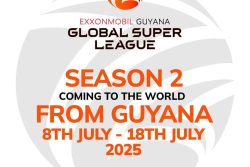The World Wildlife Fund (WWF)-Guianas on Tuesday signed an agreement with the Guyana Gold and Diamond Miners Association (GGDMA) to assist small and medium scale miners in improving their tailings management practices and said that there are some negative issues that must be urgently addressed.
The project commenced this month and will be of a practical nature through the establishment and demonstration of tailings management facilities and practices and is estimated to cost $5.6M, a press release from the WWF said. The project is expected to run until January next year.
A major problem in the mining sector is the large volumes of hydraulic tailings generated each day through the use of four, five and six inch dredges, the release stated, noting that the process involves the slurring of both overburden and gravel, resulting in a permanent loss of organic cover and slow re-vegetation. “A high percentage of this material flows directly into the receiving environment in some areas, causing turbidity plumes in waterways, blockage and diversion of waterways, reduced light penetration, siltation, channel alteration and changes in stream-bottom characteristics with their dramatic impacts on riverine ecosystems”, the WWF declared.
Stabroek News earlier this week reported about similar problems caused by mining at Arau. Residents of the Region Seven community had complained of the effects on them due to the heavily silted state of the Arau River and said that mining operations had polluted the river. Similar problems were found by Stabroek News several weeks previously near the Omai Creek.
Pointing to the contributions of mining to Guyana, the statement said too that overall, the impact on hinterland communities is varied and includes not only job creation from mining but also infrastructure development such as roads and airstrips and business opportunities. The organization said that nationally, mining supports service industries, air road and river transport, traders and shopkeepers, manufacturers of mining equipment, repairers, farmers and surveyors and the jewellery industry. However, it noted that there are also some negative impacts of mining on the environment and as a result, the inhabitants who occupy the area.
The WWF stressed that the physical degradation of the environment contributes to a variety of health effects on the local population insisting that mining activities create large areas of stagnant pools that form breeding grounds for malaria mosquitoes giving rise to the spread of the disease in many of the communities and miners. “Similarly, the contamination of rivers and streams, especially in the dry season at the height of mining activities, affects the quality of the domestic water supply of communities giving rise to diarrhea and other illnesses”, the release asserted.
The wildlife organization stated that one of the methods of addressing the negative impacts of small and medium scale mining on the bio-physical environment is the introduction of proper tailings management. It said that this involves more than the construction and operation of tailings facilities though it is the most important aspect. Tailings management require miners to provide some degree of stability and physical planning for the effective containment of predetermined volumes of tailings and effluent for specified periods of the mining operation.
WWF pointed out that the importance of proper tailings management in the mining sector has been highlighted in the amendment to the Mining Regulations and the policy document has strongly focused on the environmental issues pertaining to this topic as it is often perceived as the most significant environmental challenge associated with small and medium scale mining in Guyana.
It noted that “recently” several reports involving improper tailings management at Groete Creek and Konawaruk mining areas were publicized. Stabroek News had carried reports on these several years ago. The statement said that these reports encouraged the Guyana Geology and Mines Commission (GGMC) to act expeditiously and close these mining areas further adding that the health, environmental and financial consequences have made it clear to the mining fraternity that efficient tailings management practices are in its own best interest.
The WWF said that having recognized the stark reality associated with poor tailings management, the GGDMA has sought to acquire financial and technical assistance to ensure that its members comply with the new provisions of the 2005 Guyana Mining regulations with a view to reducing environmental impacts caused by tailings.
The release said that over the past eight years, the WWF has been providing strong financial and technical support to the mining sector in Guyana through its interaction with stakeholders to address a number of the challenges the sector experiences. “Our assistance includes grants to government agencies to improve management of the sector, training to the educational institutions and collaborative work with other partners. WWF is fully aware of the contributions of the mining sector to the socio-economic development of Guyana but also recognizes that there are also some negative issues that must be urgently addressed”, the statement said.
The WWF assured that it is fully committed to continue working with all the various stakeholders in the local mining sector in a collaborative manner to ensure that some of the major threats to the human and physical environment are minimized. “The tasks are undoubtedly enormous but WWF Guianas will continue to make gold mining pollution abatement one of the central planks of its regional environment conservation programme for the benefit of present and future generations”, the organization commented.
Funding for the project derives from several organizations and falls under the WWF Guianas Gold Mining Pollution Abatement (GPA) component of its regional project, Guianas Sustainable Natural Resources Management Project 2007- 2011.
The primary objective of GPA is to contribute to the improved management of the small to medium scale gold mining sector to reduce the pressure exerted on priority ecosystems in Guyana as a result of deforestation and contamination from the use of mercury and improper tailings management from mining activities. Both of these topics had been of concern for the residents of Arau.








